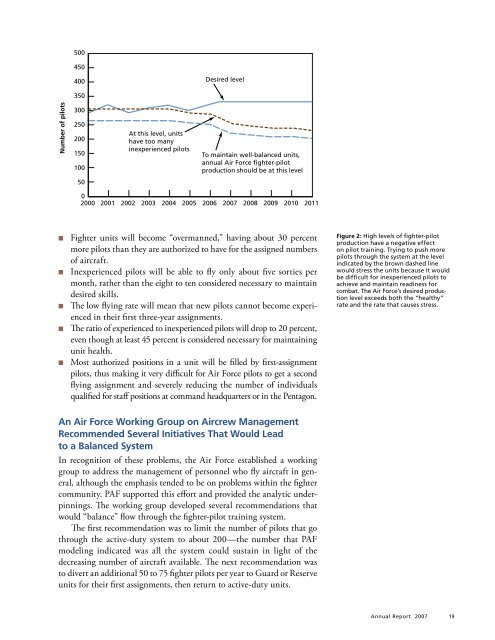RAND Project AIR FORCE Annual Report 2007 - RAND Corporation
RAND Project AIR FORCE Annual Report 2007 - RAND Corporation
RAND Project AIR FORCE Annual Report 2007 - RAND Corporation
You also want an ePaper? Increase the reach of your titles
YUMPU automatically turns print PDFs into web optimized ePapers that Google loves.
500450400Desired level350Number of pilots300250200150100At this level, unitshave too manyinexperienced pilotsTo maintain well-balanced units,annual Air Force fighter-pilotproduction should be at this level5002000 2001 2002 2003 2004 2005 2006 <strong>2007</strong> 2008 2009 2010 2011Fighter units will become “overmanned,” having about 30 percentmore pilots than they are authorized to have for the assigned numbersof aircraft.Inexperienced pilots will be able to fly only about five sorties permonth, rather than the eight to ten considered necessary to maintaindesired skills.The low flying rate will mean that new pilots cannot become experiencedin their first three-year assignments.The ratio of experienced to inexperienced pilots will drop to 20 percent,even though at least 45 percent is considered necessary for maintainingunit health.Most authorized positions in a unit will be filled by first-assignmentpilots, thus making it very difficult for Air Force pilots to get a secondflying assignment and severely reducing the number of individualsqualified for staff positions at command headquarters or in the Pentagon.Figure 2: High levels of fighter-pilotproductionhaveanegativeeffecton pilot training. Trying to push morepilots through the system at the levelindicated by the brown dashed linewould stress the units because it wouldbe difficult for inexperienced pilots toachieve and maintain readiness forcombat. The Air Force’s desired productionlevel exceeds both the “healthy”rate and the rate that causes stress.An Air Force Working Group on Aircrew ManagementRecommended Several Initiatives That Would Leadto a Balanced SystemIn recognition of these problems, the Air Force established a workinggroup to address the management of personnel who fly aircraft in general,although the emphasis tended to be on problems within the fightercommunity. PAF supported this effort and provided the analytic underpinnings.The working group developed several recommendations thatwould “balance” flow through the fighter-pilot training system.The first recommendation was to limit the number of pilots that gothrough the active-duty system to about 200—the number that PAFmodeling indicated was all the system could sustain in light of thedecreasing number of aircraft available. The next recommendation wasto divert an additional 50 to 75 fighter pilots per year to Guard or Reserveunits for their first assignments, then return to active-duty units.<strong>Annual</strong> <strong>Report</strong> <strong>2007</strong> 19
















